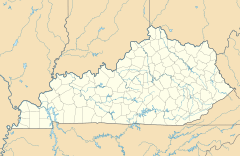Kentenia, Kentucky facts for kids
Quick facts for kids
Kentenia, Kentucky
|
|
|---|---|
| Country | United States |
| State | Kentucky |
| County | Harlan |
| Elevation | 1,247 ft (380 m) |
| Time zone | UTC-6 (Central (CST)) |
| • Summer (DST) | UTC-5 (CST) |
| GNIS feature ID | 495657 |
Kentenia is a small place located in Harlan County, Kentucky, in the United States. It is known as an unincorporated community and was once a coal town. This means it's a community that doesn't have its own local government, like a city or town would. Instead, it's managed as part of the larger county. For a period, from 1917 to 1930, Kentenia even had its own post office.
Contents
What is an Unincorporated Community?
An unincorporated community is a place where people live, but it doesn't have its own separate government. Think of it like a neighborhood that's part of a bigger county.
- It doesn't have a mayor or a city council.
- Services like police and fire protection are usually provided by the county government.
- This is different from a city or town, which has its own local laws and leaders.
Kentenia is one such community in Kentucky.
The Story of Coal Towns
Kentenia was also a coal town. This means its history and economy were closely tied to coal mining.
- Many coal towns grew up around coal mines.
- People moved there to work in the mines, digging for coal.
- These towns often had houses, stores, and schools built by the mining companies.
- Life in a coal town revolved around the mining industry.
Why Were Coal Towns Important?
Coal was a very important energy source for a long time. It was used to:
- Power factories and trains.
- Heat homes and buildings.
- Generate electricity.
So, coal towns like Kentenia played a big role in providing energy for the country.
Kentenia's Post Office
Having a post office was a big deal for a community like Kentenia.
- A post office helps people send and receive letters and packages.
- It connects the community to the rest of the world.
Kentenia had its own post office from 1917 to 1930. This shows that it was an active and important place during those years. After 1930, residents likely used a post office in a nearby town.



